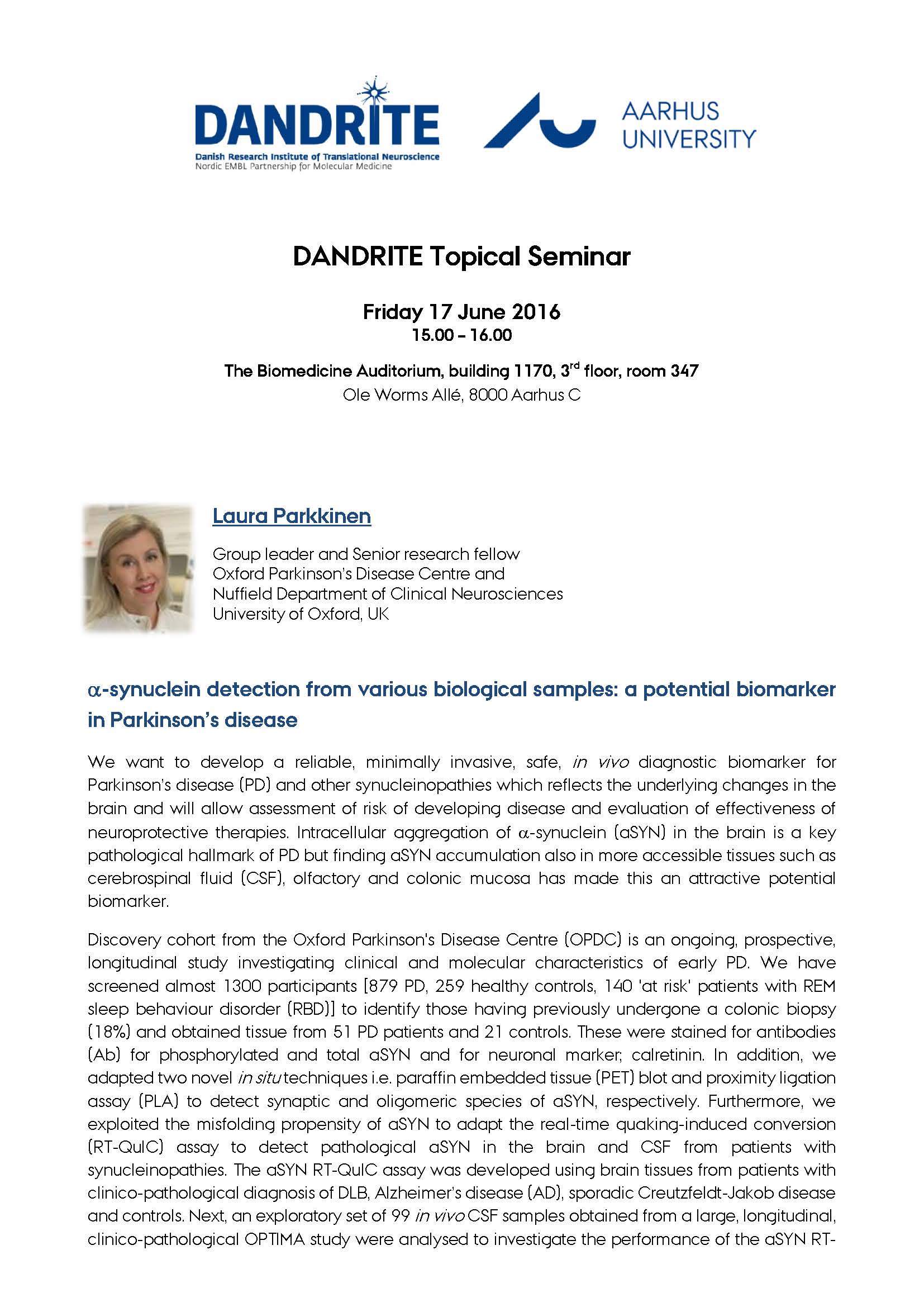DANDRITE Topical Seminar
Laura Parkkinen from Oxford Parkinson’s Disease Centre will give a talk on ?-synuclein detection from various biological samples: a potential biomarker in Parkinson’s disease.

On Friday 17 June 2016 at 15:00–16:00, Laura Parkkinen will give a talk on ?-synuclein detection from various biological samples: a potential biomarker in Parkinson’s disease.
Laura Parkkinen is a Group leader and Senior research fellow at Oxford Parkinson’s Disease Centre and Nuffield Department of Clinical Neurosciences University of Oxford, UK.
Abstract
?-synuclein detection from various biological samples: a potential biomarker in Parkinson’s disease
We want to develop a reliable, minimally invasive, safe, in vivo diagnostic biomarker for Parkinson’s disease (PD) and other synucleinopathies which reflects the underlying changes in the brain and will allow assessment of risk of developing disease and evaluation of effectiveness of neuroprotective therapies. Intracellular aggregation of ?-synuclein (aSYN) in the brain is a key pathological hallmark of PD but finding aSYN accumulation also in more accessible tissues such as cerebrospinal fluid (CSF), olfactory and colonic mucosa has made this an attractive potential biomarker.
Discovery cohort from the Oxford Parkinson's Disease Centre (OPDC) is an ongoing, prospective, longitudinal study investigating clinical and molecular characteristics of early PD. We have screened almost 1300 participants [879 PD, 259 healthy controls, 140 'at risk' patients with REM sleep behaviour disorder (RBD)] to identify those having previously undergone a colonic biopsy (18%) and obtained tissue from 51 PD patients and 21 controls. These were stained for antibodies (Ab) for phosphorylated and total aSYN and for neuronal marker; calretinin. In addition, we adapted two novel in situ techniques i.e. paraffin embedded tissue (PET) blot and proximity ligation assay (PLA) to detect synaptic and oligomeric species of aSYN, respectively. Furthermore, we exploited the misfolding propensity of aSYN to adapt the real-time quaking-induced conversion (RT-QuIC) assay to detect pathological aSYN in the brain and CSF from patients with synucleinopathies. The aSYN RT-QuIC assay was developed using brain tissues from patients with clinico-pathological diagnosis of DLB, Alzheimer’s disease (AD), sporadic Creutzfeldt-Jakob disease and controls. Next, an exploratory set of 99 in vivo CSF samples obtained from a large, longitudinal, clinico-pathological OPTIMA study were analysed to investigate the performance of the aSYN RT- QuIC. The final validation phase was carried out in vivo CSF samples derived from the OPDC Discovery cohort i.e. 20 PD, 15 controls and 3 ‘at-risk’ patients with RBD.
Using phosphorylated aSYN-Ab, the pathological deposition of aSYN in nerve cell processes was encountered in the colonic biopsies in 12 PD patients (24%) and 2 controls (10%). Using total aSYN-Ab, no staining was seen in controls but aSYN pathology was only seen in 6 PD patients (12%). PET blot improved sensitivity to 44% but the staining pattern observed was rather diffuse and difficult to quantify. Using fluorescent double-labelling of aSYN-PLA with calretinin, we detected two distinct types of oligomeric aSYN signal i.e. diffuse and cellular that did not correlate with each other. ROC curve analysis showed that neither was a reliable predictor of clinical status. RT-QuIC however detected aSYN aggregation in PD and DLB CSF with sensitivities of 95% and 92%, respectively and with an overall specificity of 100% when compared to AD and control CSF. Patients with neuropathologically confirmed tauopathies (progressive supranuclear palsy or corticobasal degeneration) gave negative responses. Interestingly, all three ‘at risk’ RBD patients had a positive RT-QuIC response suggesting that this test could be potentially used as an early diagnostic test for prodromal PD. No correlation was found between total CSF ?-synuclein measured by ELISA and RT-QuIC kinetics.
aSYN-IHC in colonic biopsies as a diagnostic biomarker of PD has low sensitivity and specificity. aSYN-PLA provides a more easily quantifiable signal than aSYN-PET, but even this technique did not reliably distinguish between PD patients and controls. Our aSYN-RT-QuIC results however were very promising providing a significant improvement on current ELISA techniques and offering a potentially valuable biomarker approach to the early clinical assessment of ?-synucleinopathies.
Host: Group Leader Poul Henning Jensen, DANDRITE, Dept. Biomedicine, Aarhus University
